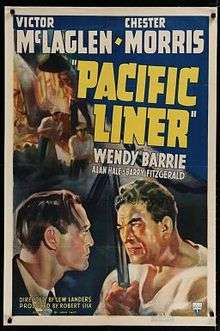Pacific Liner
| Pacific Liner | |
|---|---|
 Theatrical film poster | |
| Directed by | Lew Landers |
| Produced by | Robert Sisk |
| Screenplay by | John Twist |
| Story by |
Anthony Coldeway Henry Roberts Symonds |
| Starring |
Victor McLaglen Chester Morris Wendy Barrie |
| Music by | Robert Russell Bennett (uncredited) |
| Cinematography | Nicholas Musuraca |
| Edited by | Harry Marker |
| Distributed by | RKO Radio Pictures |
Release dates |
|
Running time | 76 mins. |
| Country | United States |
| Language | English |
| Budget | $241,000[1] |
| Box office | $508,000[1] |
Pacific Liner is a 1939 American action/adventure film directed by Lew Landers. The film stars Victor McLaglen, Chester Morris and Wendy Barrie. Pacific Liner depicts the ill-fated voyage of a disease-ridden passenger liner.[2][Note 1]
Plot
In 1932, aboard the passenger ship, the S.S. Arcturus, engineer "Crusher" McKay (Victor McLaglen) runs a "tight ship", both beloved and feared by his men. The ship's doctor, "Doc" Tony Craig (Chester Morris), has signed on in Shanghai to be on the San Francisco bound trip. He wants to be near his former sweetheart, nurse Ann Grayson (Wendy Barrie).
Crusher is also attracted to Ann but his clumsy courtship soon sets up a rivalry between him and the Doc. While under way, a Chinese stowaway infected with cholera is discovered below decks. Both Doc and Crusher are at odds with what to do. While still far from shore, the disease spreads to the men who are working on the ship's boilers. Crusher orders the doors to the decks above bolted shut, so that passengers have no idea of what is happening below. While the upper-class is being sheltered, the stokers down below begin to get sick.
As panic breaks out, with Crusher's men stricken by cholera, Ann and Doc try to keep the disease isolated. The dead stokers have to be fed into the steamship's boilers. When Crusher falls ill, his men begin to mutiny and only his stubborn determination keeps the boilers stoked. The medical team on topside is thrown together, with Ann and Doc rekindling their previous romance. Crusher's bravery eventually brings the S.S. Arcturus safely to San Francisco.
Cast
|
|
Production
Principal photography on Pacific Liner began mid-October 1938.[4] In 1937, RKO corporate head Leo Spitz had moved away from the earlier "prestige pictures" that had often been critically acclaimed but financial disasters.[5] He had not invested heavily in projects such as Pacific Liner, which had been originally intended to be released as an "exploitation quickie".[6] With reliable B-movie director Lew Landers in charge, however, the result was predictably brought "... to the screen with his usual feeling for action, and attention to narrative development ...", belying its modest status as a "B".[2]
Along with a first-rate cast with both stock players and featured performers as well as a believable storyline, Pacific Liner also had the benefit of a "lavish shipboard set ... with art deco trimmings", courtesy of art director Van Nest Polglase and his assistant Albert D'Agostino, known especially for their elaborate sets in Astaire-Rogers musicals.[6]A full-size steamship set, the first that RKO had made for their typical budget features, had mainly interior rooms but also included an exterior section with a gangplank for passengers to come on board. A large scale model was used for long shots showing the entire passenger vessel.[7][Note 2]
Reception
Variety announced that RKO's Pacific Liner was "filler in the duals."[10] The film, however, rose far above its humble origins, not only making a profit of $87,000, but with generally favourable reviews coming in, RKO consequently moved it to the top of the bill for six weeks in major theatre markets.[1] The film was also nominated at the 1939 Academy Awards for Best Original Score.[11]
References
Notes
- ↑ The real S.S. Arcturus was a passenger liner of the Finland Steamship Company operating primarily on the route between Hanko, Finland and Hull, England via Copenhagen, Denmark.[3]
- ↑ The cost of the set was amortized over the years and it appeared again as the setting for RKO's The Ghost Ship (1943), a low budget film that could use the still standing set.[8][9]
Citations
- 1 2 3 Jewell 1994, p. 56.
- 1 2 Jewell 1982, p. 136.
- ↑ "Journey from Finland to America." genealogia.fi. Retrieved: November 9, 2014.
- ↑ "Original print information: Pacific Liner (1939)." Turner Classic Movies. Retrieved: November 9, 2014.
- ↑ Jewell 1982, p. 100.
- 1 2 Neuhaus, Mel. "Articles: Pacific Liner (1939)." Turner Classic Movies. Retrieved: November 9, 2014.
- ↑ Bansak 2003, p. 204.
- ↑ "Did you know: Pacific Liner (1939)." IMDb. Retrieved: November 9, 2014.
- ↑ "Trivia: The Ghost Ship (1943)." Turner Classic Movies. Retrieved: December 17, 2014.
- ↑ Schatz 2004, p. 148.
- ↑ "Awards: Pacific Liner (1939)." IMDb. Retrieved: November 9, 2014.
Bibliography
- Bansak, Edmund G. Fearing the Dark: The Val Lewton Career. Jefferson, North Carolina: McFarland & Company, 2003. ISBN 978-0-7864-1709-4.
- Jewell, Richard B. "RKO Film Grosses: 1931–1951". Historical Journal of Film, Radio & Television, Vol. 14, No 1, 1994. ISSN 0143-9685.
- Jewell, Richard B. The RKO Story. New Rochelle, New York: Arlington House, 1982. ISBN 0-517-54656-6.
- Schatz, Thomas, ed. Hollywood: Critical Concepts in Media and Cultural Studies, Volume 1. Abingdon, UK: Taylor & Francis, 2004. ISBN 978-0-41528-132-4.
External links
- Pacific Liner at the TCM Movie Database
- Pacific Liner at the Internet Movie Database